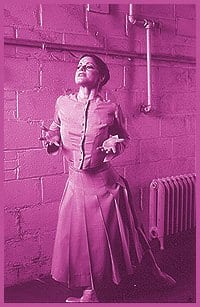“There’s my record with Boris Karloff reading,” says James Kudelka, gesturing to an old album of The Pied Piper on his office shelf. “I don’t know how many times I listened to it as a kid.”
In the highlight of the National Ballet Of Canada’s 50th anniversary season, Kudelka has married two seemingly incongruous stories – the life of Canadian-born evangelist Aimee Semple McPherson and Robert Browning’s beloved poem The Pied Piper Of Hamelin. The Contract, the artistic director’s first ever, original, full-length story ballet, opens this weekend.
McPherson was born in Salford, Ont in 1890 and became an incredibly successful – and controversial – evangelist in the US. Her first husband died during a missionary stint in China. Following her second marriage McPherson overcame deep depression after receiving a message from God to preach the Gospel. McPherson would go on to be the first woman to preach on radio; she built the huge Angelus Temple in LA and found The Church Of Foursquare Gospel.
Success bred enemies. In 1926, she disappeared for a month, claiming to have been kidnapped. The press and possible conspirators mounted a campaign to discredit her with allegations of sexcapades.
Other scandals followed, but still McPherson was able to do amazing work all through the Depression; she died of an accidental overdose in 1944.
In The Contract, McPherson has metamorphosed into Eva, the Piper character, who arrives inexplicably in a town panicking as a mysterious plague spreads. She promises to save the town and negotiates a contract with the mayor and town corporation. She works her healing magic through the laying on of hands.
In this version, Kudleka adds the element of sexual impropriety. A child witnesses the impassioned love-making between Eva a young man from the town. The townsfolk are outraged and break their contract with the stranger.
“We wanted to create a community had a skeleton in its closet,” says Kudelka. “The Piper would do something that the community couldn’t buy. And that becomes this [sexual] relationship.”
Disgusted, Eva leaves and all of the children in the town follow her – perhaps by choice.
“Rejecting Eva sends a ripple throughout the community – the kids are watching,” says Kudelka. “I’m just at the point now where I realize that she represents an awareness to the kids. It’s not that she gathers them all up and takes them away or takes their future away: The future takes itself away.”
While the story and dynamics among the characters need to be clear, Kudelka doesn’t want the ballet’s meaning sewn up; there are no villains. “It should have the same sense of wonder at the end that I got reading it as a kid: ‘What really happened? Was it good or not?’ I just was never sure and that’s why it had such a strong pull.”
In McPherson, Kudelka found a character at once charismatic, full of faith, hope and ecstatic love and yet, not a cardboard cut out Bible thumper – she has to be very human. All of these characteristics he sees in principal dancer Martine Lamy on whom he’s creating the role. “We took McPherson as a beginning, but now she’s very much become this wonderful talent that is Martine Lamy, who’s really doing an amazing job. This is the piece I’ve wanted to do for her for years.”
Over the long gestation period for The Contract, Kudelka used Bob Sirman as a sounding board; Sirman, who is the administrative director of the National Ballet School and board chair of the Toronto People With AIDS Foundation, is now credited as the ballet’s librettist.
“My role developed very informally. All of a sudden I was meeting the other collaborators and I thought, ‘Oh, Jesus. I’m one of them,'” Sirman says, laughing. It’s a high-powered collaborative team: set designer Michael Levine (the gay former Torontonian gets opera commissions all over the world), composer Michael Torke (who composed Javelin for the 1996 Olympics; Kudelka set Terra Firma to his Color Music), costume Denis Lavoie (who did Kudelka’s beautiful Four Seasons), Shaw fest lighting designer Kevin Lamotte and sound designer John Oswald (Plunderphonics; the soundtracks to such films as Hustler White).
“We began in 1995,” says Sirman. “It’s hard to put ourselves back into the anxiety of that period in our community. The year ’96 was a milestone, when drug therapies were first introduced. So the ballet began when notions of plaque and contagion were still very compelling and gripping – as was the idea of a whole generation disappearing.
“Since then those concerns have become increasingly general and metaphorical in the ballet.” The plague appears as a movement affliction set to an infectious rhythm. “It’s now more about fear of things we can’t control, especially things from outside.”
The Contract opens with the children of the town performing a play of The Pied Piper. Kudelka held a workshop of the kids’ production and says all the big name talent delighted in fussing over the junior students of the ballet school. The kids’ homespun costumes and sets even inform the ballet’s overall design. The perspective of children informs the production in other, surprising ways.
For both men, involving the youngest members of the company is much more than art making, it’s about community building. “From the beginning, James wanted this to be a multi-generational piece,” says Sirman. “It’s about the relationship between a community and its children.”
The ballet’s story and process have parallels. Sirman notes that Kudelka has vivid memories of being a young student at the National Ballet School. “He remembers how people did not appreciate how much children understood of the world.”
For his part, Kudelka talks about acknowledging the grand tradition of ballet, where generations of great artists influence the next. “I keep trying to figure out what it means to be a mentor – not being a dad – as a director.
“That life in the theatre thing – where you’re in the theatre from childhood and your watching the stars, but your also watching the Vickie Bertrams and the Hazaros Surmeyans,” says Kudleka, referring to the wonderful older dancers at the National. “Like all of the great ballet companies with schools attached, that’s what we have here.
“I always thought that doing something like this was the ideal way to run the company. A lot of things start to fall into place when your working on something new. Every department in the building is working on it, everybody has their role.
“I keep telling people that this should be the best of times,” Kudelka says, breaking into a laugh. “The fact that I have to say that means that we haven’t got it all sorted out just yet.”
In rep with the short program of Apollo, Intermezzo and Voluntaries, The Contract closes the National’s 2001/02 season, comprised of a total of six ballets and short programs. “If we are really going out on a limb and having one sixth of our repertoire be as expressive can be, as an organization,” says Kudelka, “we should be using the full company, calling in all of our forces because it’s the one thing that makes sure that the activity of the company shows its purpose, the scale of the company can be explained, the gloriousness of all that.”
With The Contract, Kudelka reaffirms a faith in his creative powers, in the depth of talent in the National and the power of dance to touch audiences.
The Contract.
$26-$110.
Sat, May 4, 5, 14-18.
Hummingbird Centre.
1 Front St E.
(416) 345-9595.


 Why you can trust Xtra
Why you can trust Xtra


